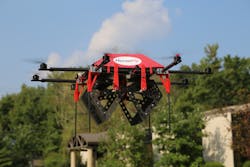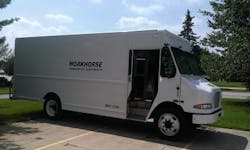Amp charges into electric trucks, delivery drones
Since its purchase of the Workhorse brand from Navistar in late 2012, Amp Holding, parent company of Amp Trucks, has been working towards electrifying the step van chassis. With the announcement on Wednesday that a “major transportation company” had ordered 18 of its all-electric Workhorse E-100 walk-in vans, that process is taking its next steps. But it’s not just in the electric truck market that Amp wants to play, the company is also looking to become a provider of delivery drones. And CEO Steve Burns told Fleet Owner in an exclusive interview that Amp expects to succeed in the marketplace where others have faltered, and even failed.
“First off, nobody built their own chassis,” he said. “They all retrofitted a chassis. Azure retrofitted the Ford chassis. Smith imported a chassis from the Czech Republic. The second thing is the batteries. None of those guys controlled their batteries. They essentially outsource their batteries (and battery systems) and used automotive (systems). Tesla uses commodity batteries and built (a system) around it. We did the same thing. We’ve built a system around commodity batteries.
The E-100 van features a 100 kWh Lithium battery pack featuring Panasonic 18650 cells, the same battery cells used by Tesla in its vehicles, that “provide power to a 2200 nm permanent magnet motor powerful enough to eliminate the need for a transmission,” Burns said.
There are a few keys to the vehicle, Burns relates, that he believes will make it a fleet success. First, the use of the batteries, which Panasonic “literally makes a billion of a year,” keeps costs down on that front due to the scale of production. Second, the elimination of a transmission altogether saves weight, meaning that less battery power is needed to move the vehicle so Amp could “right-size the battery pack,” Burns noted.
That was a game-changer, Burns said, because previously electric vehicle makers retrofitted chassis to their systems. The Workhorse chassis is purpose built for electric power.
The choice to go with Panasonic battery cells is also helping Amp reach customers.
“Once we tell people we are using Panasonic batteries just like Tesla, the battery discussions (and concerns) are over,” Burns said.
Burns added that because “transmissions are energy-robbing and a maintenance headache,” the elimination of this traditional vehicle component, while also reducing weight, is another bonus. “To lose that … is a game-changer,” he said.
The E-Gen system itself is unique in that it uses a generator to provide “emergency” backup power when needed.
“Typically [step vans] go 50 or 60 mi. a day, but everybody puts in batteries that can go 100 mi.,” Burns said. “We also saw that these vehicles typically stop a lot during the day. The generator only runs when the vehicle is turned off.”
The way the system works, Burns explained, is the vehicle operates on electric power during its operation. But, because the range of the batteries is lower to match a typical daily route, the potential to run out of electric power exists. To combat that, Amp developed the E-Gen. The E-Gen is similar to a small stationary generator and operates on gas, natural gas or propane. When the van is turned off, the system checks the battery levels and if needed, turns on the 25-hp. generator to recharge the batteries.
“Only a small amount of fuel is needed,” Burns said. “But in a typical day, the E-Gen probably would not be needed.”
The end result is, again, a smaller, lighter system that is also lower priced, resulting in a three-year payback on the vehicle.
The E-100, though, is not Amp’s only foray into advanced electric technology. The company is also preparing the “Horsefly.”
The Horsefly is a battery-powered unmanned aerial vehicle (UAV). It is similar to Amazon’s drone delivery concept in that it will deliver packages to front doors. Unlike Amazon’s idea, which dispatches drones from centralized warehouses, Amp’s Horsefly sits atop a delivery vehicle in a “portal.”
“[Amazon’s] model, with a centralized warehouse and drones flying out of that, we don’t think that will work because of the [battery] weight needed [to fly distances],” Burns said. “This is really a mobile warehouse.
“In the end, these things are electric, so the battery is key,” Burns added. “Most of what is out there is ‘hobby grade,’ what we’re building is commercial grade.”
The eight-rotor drone is being developed in conjunction with the University of Cincinnati’s Dept. of Aerospace Engineering and Engineering Mechanics. Burns explained that the drone sits on top of a vehicle, charging when not in use. A driver can than walk back into the cargo area, pick up a package and pass it up through the portal to the drone, which clamps onto the box (up to 10 lbs.), reads the barcode to locate the delivery address, and then flies off.
While the drone is making its delivery (being guided by a “pilot” back at a call center to ensure the package is landed safely in the appropriate spot), the driver can get back into the driver’s seat and go on to his next delivery, improving efficiency. When the drone has completed its task, it locates the current location of the vehicle and returns to the portal atop the roof, ready for its next delivery.
“It’s not going to be for every delivery,” Burns said, “but there are ones where it will make sense.”
The commercial use of drones is currently restricted by law, Burns said, but there is hope that the government will change the regulations by next summer to allow their use. If that happens, Burns said Amp’s Horsefly will be ready to deliver.

